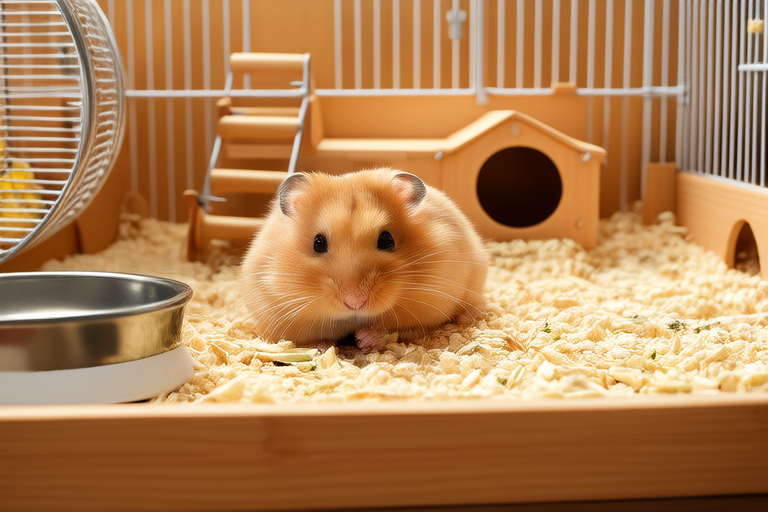Secrets to Creating the Ultimate Hamster Habitat
Hamsters make delightful pets, known for their small size, gentle nature, and endearing behaviors. However, to ensure your hamster thrives, it’s crucial to provide them with a comfortable, stimulating, and safe living environment. This article will guide you through creating the ultimate hamster habitat, covering various aspects from choosing the right cage to maintaining hygiene.
Selecting an Appropriate Cage Size and Type
The first step in setting up your hamster’s home is selecting the right cage. The cage should be spacious enough to allow your hamster to move around freely, explore, and play. A general rule of thumb is that the cage should be at least 36 inches long, 18 inches wide, and 12 inches high for Syrian hamsters, while dwarf hamsters require slightly smaller but still adequate space.
When choosing a cage, consider the material and design. Wire cages offer excellent ventilation but may not be ideal for certain types of bedding, which can escape through the gaps. Glass or plastic aquariums provide better insulation and prevent bedding from escaping but might have less ventilation. Opt for multi-level cages with ramps and platforms for dwarf hamsters to mimic their natural climbing habits.
Essential Bedding Materials for Comfort and Health
Choosing the right bedding is crucial for your hamster’s health and comfort. Avoid cedar and pine shavings as they contain aromatic oils harmful to hamsters. Instead, opt for paper-based bedding or recycled paper products, which are safe, absorbent, and dust-free. These materials help maintain hygiene and reduce respiratory issues.
For nesting, provide soft, fluffy bedding like cotton or shredded tissue paper. Hamsters enjoy burrowing and creating nests, so ensure there’s enough nesting material for them to feel secure. Additionally, cardboard rolls and toilet paper tubes serve as fun, chewable alternatives that keep your hamster entertained.
Necessary Toys and Accessories for Mental Stimulation
Toys and accessories are vital for keeping your hamster mentally stimulated and physically active. Provide tunnels, bridges, and wheels for exercise and exploration. Wheels should be solid and smooth to prevent injuries. Dwarf hamsters tend to run more than Syrian hamsters, so consider a larger wheel for them.
Incorporate chew toys made from untreated wood or cardboard to satisfy your hamster’s natural chewing instincts. These toys help wear down their continuously growing teeth, preventing dental problems. Puzzle feeders and treat balls also engage their minds, offering mental challenges and rewarding them with treats.
Balanced Diet and Feeding Tips
A balanced diet is essential for your hamster’s overall health. Hamsters are omnivores, meaning they eat both plant and animal matter. Offer a mix of commercial hamster food, which contains a blend of seeds, grains, and pellets, along with fresh vegetables and fruits. Rotate the vegetables and fruits to ensure a varied diet rich in vitamins and minerals.
Provide a constant supply of fresh water in a water bottle with a sipper tube. Check the water daily to ensure it remains clean and accessible. Avoid giving your hamster foods that are toxic to them, such as chocolate, caffeine, citrus fruits, and raw beans.
Safe and Suitable Exercise Options
Exercise is vital for maintaining your hamster’s physical and mental health. In addition to the cage toys and accessories, provide supervised out-of-cage time for safe exploration. Use a hamster ball or a playpen to ensure they remain contained and safe during playtime. Rotate toys and activities to keep your hamster engaged and prevent boredom.
Ensure the area is free from hazards such as open water sources, electrical cords, and small openings where your hamster could get stuck. Regular exercise helps maintain a healthy weight and prevents obesity-related health issues.
Maintaining Hygiene and Cleaning Routines
Hygiene is paramount to prevent illnesses and ensure your hamster’s well-being. Clean the cage weekly, removing soiled bedding and replacing it with fresh material. Disinfect the cage and accessories using pet-safe disinfectants to eliminate bacteria and odors.
Regularly check for signs of illness, such as lethargy, loss of appetite, or changes in behavior. If you notice any concerning symptoms, consult a veterinarian specializing in exotic pets. Maintaining a clean and hygienic environment promotes longevity and a healthier life for your hamster.
Common Pitfalls to Avoid When Setting Up the Habitat
Avoid placing the cage near direct sunlight or drafts, as these can cause stress and temperature fluctuations. Ensure the cage is placed in a quiet area away from household noise and activity. Overcrowding the cage with too many toys or accessories can lead to a cluttered space, making it difficult for your hamster to move around comfortably.
Be cautious about using bedding that clumps or sticks to your hamster’s fur, as this can lead to skin irritation or infections. Also, avoid overfeeding treats, as they can lead to obesity and nutritional imbalances.
Creating the ultimate hamster habitat requires careful consideration of various factors. By providing ample space, suitable bedding, mental stimulation, a balanced diet, safe exercise options, and maintaining hygiene, you can ensure your hamster lives a happy, healthy, and fulfilling life. Whether you’re a new or experienced hamster owner, these guidelines will help you create a nurturing environment for your furry friend.
